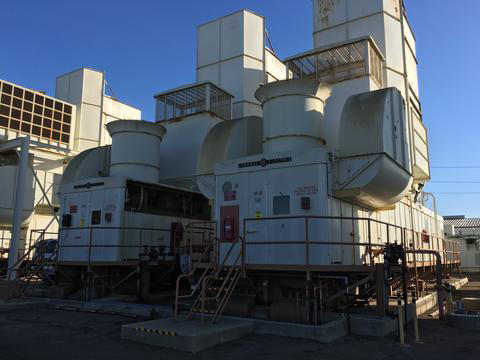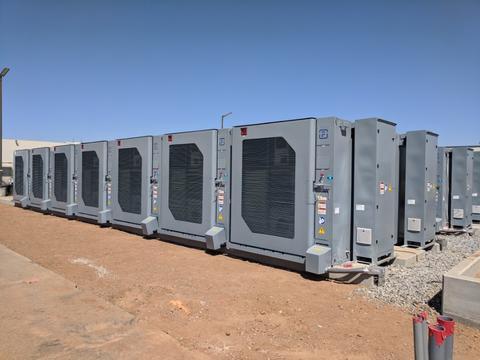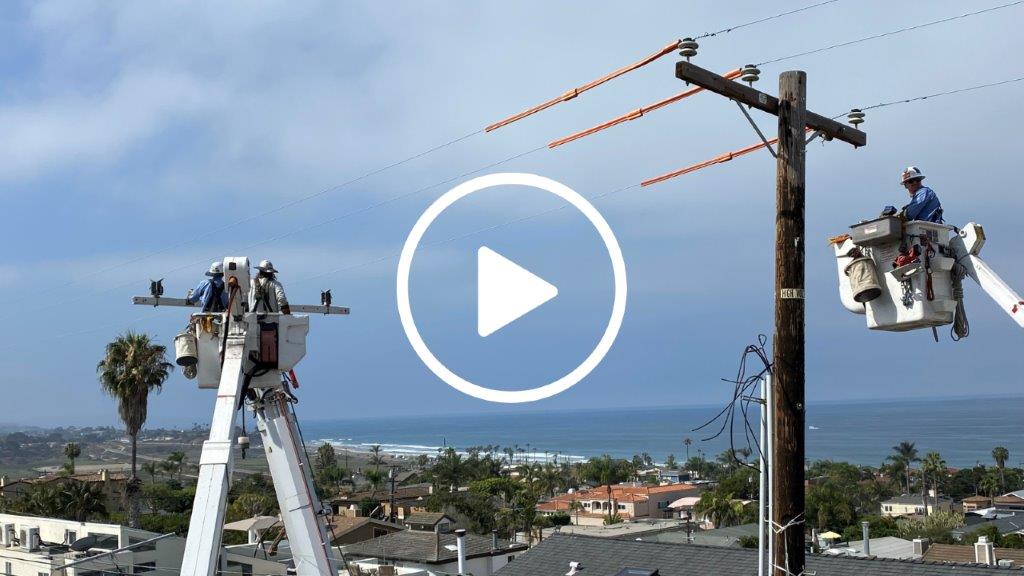
Preparing the Grid for a Hotter Than Normal Summer
We are several weeks into summer, and the weather is already shaping up to be like last summer – one of the hottest on record. If you look at NOAA’s nationwide weather forecast through August, you’ll see a heat map of our country covered almost entirely in shades of red, orange and gold. The colors indicate anywhere from 33% to 80% probability that summer temperatures will be higher than normal. Texas has already experienced sustained hot temperatures throughout June and early July that triggered high demand for electricity and the real threat of rolling blackouts.
Energy use ramps up on hot days when millions of air conditioners crank away to keep homes and businesses cool. The challenge our engineers face is to ensure our energy grid keeps up with that spike in demand along with normal day-to-day needs. So, I wanted to take the opportunity to let you know what SDG&E is doing to prepare for a hotter than normal summer and the energy needs of our region’s 3.7 million residents.
Climate change is making the hot hotter and the dry drier. Multi-disciplinary teams across our company have been working diligently to add electric generation resources and energy storage capacity needed to store electricity produced by the sun and wind. Our customer programs team has also expanded energy conservation programs to encourage customers to reduce their energy use when the grid is stressed. Read on and see how you can get paid for cutting back on energy use.
But let’s start with the energy grid first. Our regional electric transmission system is interconnected with the rest of California, which is in turn interconnected with other Western states. Given that interdependency, summer reliability is truly a team effort. What happens in Northern California or even out of state in Oregon can impact the grid’s ability to meet customers’ energy demand in San Diego, and vice versa.
For that reason, we must work very closely with state agencies – such as the California Independent System Operator (CAISO), California Public Utilities Commission (CPUC) and California Energy Commission (CEC) – on both short-term and long-term strategies to make the grid safer and stronger. SDG&E is advocating for a regional transmission organization to be created to optimize the flow of electricity across the West to help enhance reliability and reduce costs for customers.
Regional Grid Capacity Has Been Expanded
From an electric resource perspective, I can say unequivocally that we are in a better place today than we were two years ago. Consider these statistics.
- Since the summer of 2020, SDG&E has brought more than 260 megawatts (MW) of capacity online, mostly in the form of energy storage (the energy equivalent of powering about 173,000 homes on an average day and about 74,000 on a peak summer day for up to four hours). This includes our newest battery facilities in Kearny Mesa and Miramar. By the end of 2022, SDG&E expects to add another 140 MWs to our portfolio – including a 40 MW storage facility currently under construction in Fallbrook, our largest to date. Statewide, electric system capacity was projected to grow by more than 7,500 MWs between June 2021 and June 2022, according to a CAISO report issued in May .
- SDG&E has also significantly expanded our suite of energy conservation programs, which pay customers for using less energy when the grid is stressed. Currently, about 570,000 SDG&E residential customers are enrolled in our newly launched Power Saver Rewards program. In effect through October, this program credits customers with $2 per kilowatt hour saved during the peak hours of 4-9 p.m. when CAISO declares a Flex Alert or other grid emergencies. All customers can sign up for the program. I did it online, and it was very easy to do. SDG&E also offers a similar program called the Emergency Load Reduction Program for business customers, which also provides $2 per kWh or $2,000 per MW for verified load shed. Neither program carries a penalty if you aren’t able to reduce energy use.
If you want to learn more about these programs and enroll in them to save on your bill and help make the grid more reliable for all Californians, please visit Demand Response Programs | San Diego Gas & Electric (sdge.com). And please share this information with your friends and neighbors.
Fundamental Changes
When I first joined the energy industry over three decades ago, planning for the summer was pretty straightforward. We looked at historical energy usage data to guide us and relied on power plants that could be turned on at the flip of a switch and run 24/7/365.
Today, our energy grid is quite different – powered by vast amounts of weather-dependent, renewable energy and a growing portfolio of energy storage. We are seeing more stress on the grid due to more extreme weather conditions. Keeping the grid reliable now requires a highly complex orchestration of diverse resources, and more than ever, it requires everyone to pitch in to help.
Thank you in advance for doing your part. And you have my word that our 4,600 employees are doing our very best to make the grid stronger.

Caroline Winn
Chief Executive Officer
***
Getting to Net Zero is a Team Sport
For more than half a century, the north end of SDG&E’s Kearny Mesa Construction and Operations Center housed a power plant. Originally built in the 1950s, the electric generators onsite first burned oil, then diesel and finally natural gas, before they were shut down in 2019. Today, SDG&E’s Kearny North Battery Storage occupies the footprint where combustion generators used to sit. It’s a similar story at our Miramar operations yard, where we have added energy storage next to a former power plant site.

Kearny's history - old combustion generators

Kearny today - battery storage facility
The transformation at these facilities within the past two years and the fact that the electric sector has reduced its carbon emissions by 42% over the last decade speak volumes about where SDG&E, our region and state are headed, which is toward 100% clean energy – a carbon neutral future where the amount of carbon we produce is offset by the amount we remove from the atmosphere.
How California should go about achieving its goal to be carbon neutral by 2045 is one of the most important policy questions of our time. SDG&E has an important role to play but getting to net zero is a team on which we all need to play. That is why SDG&E recently commissioned a year-long study with robust analyses to provide insights on how and what will be needed for our state and region to transition to a clean energy economy in a reliable, affordable and equitable way.
New Study Provides Decarbonization Roadmap
The Path to Net Zero: A Decarbonization Roadmap for California outlines our vision for California to reach net zero emissions by 2045 based on what we know today. It differs from other studies in that for the first time the electric reliability industry standard was modeled using industry-specific tools.
Key Takeaways
SDG&E’s analysis found that a diversified decarbonization framework is the optimal path to reach California’s climate goals, specifically a combination of expedited electrification paired with clean fuels such as clean hydrogen and carbon removal. The study is quite expansive, so let me touch on just a few key takeaways.
There is no question the electrification of most buildings and vehicles in California is necessary. Indeed, our analysis also indicates electricity consumption in the region and state could nearly double by 2045. As a result, the amount of clean electric generation resources the state will need is about four times that of 2020 levels. While consumers will be the ones purchasing vehicles and appliances, and energy suppliers building new wind and solar facilities, SDG&E will be responsible for a massive expansion of the power grid needed to accommodate this surge in electricity use in order to help ensure the state can reduce emissions while safeguarding electric reliability. Ultimately, there is a role for everyone –consumers, community choice aggregators, cities, counties, and manufacturers among many others. For example, we envision residents and businesses participating in demand response/energy conservation programs, community choice aggregators meeting their clean energy goals, and cities and counties electrifying, among other actions.
Our study also found that clean fuel technologies such as clean hydrogen produced with wind or solar electricity would be needed to serve two critical functions: 1) power industrial operations and sectors that are difficult to electrify, such as long-distance trucking; 2) serve as a fuel for power generation to complement solar, wind and battery storage.
Policy and Regulatory Support
The scale and pace of the transformation needed over the next two decades is unprecedented. All sectors of the economy need to do much, much more, a lot faster. To be precise, according to our study, California needs to decarbonize at 4.5 times the historical pace to get to net zero by 2045. And to pave the way for implementation of the Roadmap, the state must take significant policy and regulatory actions to:
- Identify state resources and reform utility rates to maintain affordability and enhance equity
- Incentivize research and development to spur innovations
- Establish the right policy framework to enable carbon capture, storage and utilization, and expedite decarbonization infrastructure by simplifying the regulatory approval process
- Incorporate electric system reliability into the state’s long-term planning, create a regional transmission organization and adopt inclusive technology solutions
The magnitude of the challenge ahead of us is awe-inspiring. The option to do nothing is not sustainable; if anyone can meet this challenge, it’s California. A tremendous opportunity to cement California’s leadership in sustainability on a global scale lies ahead. I am already heartened by the tangible progress we are seeing in Miramar and Kearny Mesa, and everywhere throughout our region and California. But SDG&E can’t do it alone. Our goal is to add to the conversation and stimulate collaboration across public, private, nonprofit and academic sectors to drive progress toward carbon neutrality, and my hope is you’ll join us. Please reach out if you have any questions or feedback regarding the Roadmap. As always, we welcome your thoughts and participation. Together, we can rise to the challenge and seize the opportunity to show the world that it is possible to decarbonize the economy in a reliable, affordable and equitable way.

Caroline Winn
Chief Executive Officer
***
Climate-Proofing Our Energy Systems
As the chaos and uncertainty around the pandemic continues, I hope you, your families and colleagues are staying safe and healthy. I couldn't be prouder of the SDG&E team, those who show up onsite every day to ensure continuity of the essential services we provide, as well as about half of our workforce who are still working from home. While this scenario has certainly presented unique challenges, it's been remarkable to see how flexible and adaptable the team has been to new safety protocols and day-to-day work processes. The show must go on, and the team hasn't missed a beat.
With September being designated as National Preparedness Month, I thought it was appropriate to talk about the work that SDG&E has undertaken to ensure our region is better prepared for disasters and emergencies that could happen at any time. Unfortunately, our region has dealt with our share of emergencies over the past several decades. However, I believe we are a stronger and more prepared region because of it. Climate change is exacerbating the risks of disasters, and 2021 is quickly being defined as yet another year of extreme weather and climate-related impacts across California, the United States and the globe. We have seen record-breaking cold and hurricanes cripple southern states, followed by extreme heat and drought across the west, driving another devastating wildfire season.
Growing Severity of Climate Threats
The severity of climate threats facing California was recently underscored by White House National Climate Adviser Gina McCarthy’s visit to San Diego. She toured the site of the Del Mar bluff collapse – a vivid example of the danger posed by sea level rise. Along with Representatives Scott Peters and Mike Levin, she also stopped by SDG&E’s Emergency Operations Center to learn about our wildfire safety and climate resilience advancements.
We shared the many lessons SDG&E has learned from years of building programs and technologies from the ground up to respond to extreme weather events, and how those hard-earned lessons have better positioned our company. We talked about the tireless work and, importantly, the culture of the company to strive to innovate and continuously improve, which has reshaped our organization and put us in a leadership position in climate resiliency and adaptation.
None of us at SDG&E is letting down our guard. If anything, we are redoubling our efforts to strengthen our regional energy systems against growing climate threats. I know many of you are wrestling with climate change as well and share a sense of urgency to climate-proof our infrastructure. Climate resilience is fundamental to our region's future and will require unprecedented efforts and investments by all of us.
SDG&E began investing in climate resilience in 2007, starting with bolstering our grid against the growing threat of wildfires. While continuing to build on our wildfire safety work over the past decade, we have also broadened our efforts to address other aspects of climate change, such as sea level rise and extreme heat.
Strengthening the Grid with New Technology and Innovations
SDG&E has hundreds of projects in flight to mitigate the impacts of climate change and several technologies that I am personally excited about. Energy storage (better known as large batteries) can store green electricity (electricity generated from renewable resources) during the day and utilize it later in the day, when the sun stops shining and wind stops blowing, to help prevent the kind of outages California experienced last August.
SDG&E has been steadily adding more storage capacity over the past decade, while also pioneering technologies that can provide backup power for more than a few hours. Earlier this summer, we flipped the switch on a 30-megawatt (MW) battery facility in the Miramar area. We plan to triple the amount of energy storage in our region to store clean energy for use during peak hours by year end.
Energy storage is an integral part of the clean energy transition due to its ability to add energy on to the grid when the sun isn’t shining and keep the lights on for customers.
Another important tool to build community resilience is microgrids. These small-scale electric grids can operate independently of the larger grid to keep a targeted area or facilities powered during emergencies. SDG&E built the first utility-scale microgrid in America in 2013 in the remote desert town of Borrego Springs. We are now working to add four microgrids to support vulnerable communities in high fire-risk areas, and critical facilities such as the Cal Fire’s Ramona Air Attack Base, where regional firefighting assets are based.
Our engineers are pushing the envelope with the design of these next generation microgrids to run them on renewable energy. Almost all the new microgrids have onsite solar generation and will be equipped with advanced energy storage.
Localized microgrids can help deploy more zero-emissions energy sources, provide energy independence, and improve grid resilience to extreme weather events.
Climate Adaptation and Resilience Will Take All of Us
Last month, the Intergovernmental Panel on Climate Change (IPCC) released their latest report which was described as a “code red for humanity.” Climate change is not waiting on us. We have a unique opportunity now to confront it and our collective sense of urgency of time and investments must be a priority. For real change to take root and nurture, collaboration across all sectors is imperative. Strong partnerships can unlock the future of climate-friendly technologies. The good news is we live in a region known for innovation, groundbreaking climate research and cross-sector collaboration. We can and will make a difference and catapult our region as a leader and example of what other cities should be doing. SDG&E is committed to being your partner and I encourage you to reach out to me directly with your thoughts and feedback on how we can work together.

Caroline Winn
Chief Executive Officer
***
Celebrating Earth Day 2021 with Optimism for a Net Zero World
In the 1960s, the call to action for my generation was to send a man to the moon. Today, our moonshot challenge is to eliminate greenhouse gas emissions (GHG) from our economy without losing sight of energy affordability and reliability. Having worked in the energy industry for more than three decades and having seen how rapidly it’s evolved in the past two decades, I feel optimistic we can get there.
It is with this goal in mind – and a spirit of collaboration – that I kick off this column on the eve of Earth Day 2021. My goal is to connect, on a quarterly basis, to share insights on climate challenges, spotlight innovative solutions (many of which are being developed right here in San Diego), and spark collaboration among diverse stakeholders.
We are home to world-renowned institutions that pioneered climate research, innovative clean-tech companies and civic leaders who are committed to sustainability. Our region has a track record of coming together to address big problems, such as catastrophic wildfires, widespread power outages and extreme weather to name a few. Still, we have our work cut out for us. As individuals and collectively, we all have a role to play to combat the effects of climate change.
At SDG&E, climate is the centerpiece of our business strategy. Recognizing our responsibility as an energy company to help build a more sustainable future, we have committed to reaching net zero greenhouse gas emissions by 2045. That means eliminating all emissions associated with the generation of electricity, the delivery of electricity and gas to customers, and the usage of energy by customers.
What Gives Me Hope?
Consider these statistics:
- In 2000, there were six rooftop solar systems interconnected to SDG&E’s electric grid. Today, there are more than 210,000 – an astounding 35,000-fold growth in 20 years and the most of any investor-owned utility. Many of these were made possible by a patented device invented by SDG&E employees to make solar interconnections easier and cheaper.
- Back in 2000 – the year the Prius was first introduced to the American market – EVs were rarely seen on the road. Today, our region is home to more than 60,000 plug-in vehicles that produce little or no tailpipe emissions, the largest source of GHG emissions and the biggest opportunity to clean our air. Today, EVs are being powered by an increasing amount of renewable energy on the grid and a growing network of chargers built by SDG&E.
- Twenty years ago, climate action plans and climate equity were not a part of our vocabulary. Today they are commonplace and for SDG&E engrained in our values, fueling our push to bring energy innovations to every neighborhood in our service territory.
As we’ve watched solar penetration and the adoption of electric vehicles grow, the opportunity has arisen to use energy storage to store electricity produced in the middle of the day until it’s needed when the sun goes down and to help power and charge electric fleets, the most critical part of our transportation transition. Many energy experts believe that green hydrogen– produced with solar energy that is so abundant in our region and in California – is another glidepath to decarbonize natural gas. Hydrogen technology is expected to follow a similar trajectory to solar, becoming the basis for longer-duration energy storage and a means to power trucks, container ships and other heavy-duty transport equipped with fuel cell technology. Key to meeting our 2045 net zero pledge, SDG&E announced two hydrogen and additional energy storage projects this week and I look forward to sharing updates on our progress.
The Race to Net Zero is On
Getting to net zero may seem like a tall task, but so was sending a man to the moon. That is until Americans resolved to make it a reality. On Earth Day 2021, let’s mobilize and align our resources and talents across all sectors to make net zero a reality as quickly as we can. Utilizing creativity, technology, and innovation, we can do it , one project at a time.
I welcome your feedback and ideas. Please feel free to reach out to me at [email protected]


Caroline Winn
Chief Executive Officer
